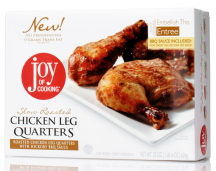Mexico joins Canada with COOL complaint
More consumers prefer bigger packaging
Sara Lee launches new nutritional labels
Joy of Cooking now in frozen aisle
Liquified ‘peanut butter’ packaged in pouch

by Pan Demetrakakes
Executive Editor
The conventional wisdom is that the food industry is not as prone to the vicissitudes of economics as other sectors. Even in a recession, people have to eat, as the saying goes.
Maybe. It’s certainly true that very few food company executives now wish they could trade places with anyone at Detroit or Wall Street. But a look at the financial pages shows us that the food industry is far from immune. Consumer confidence, commodity and energy prices, and a host of other factors are causing problems across the sector.
Andrew Lazar, an analyst for Barclays Capital, recently downgraded the packaged foods sector as a whole to “neutral” from “positive.” He said major food companies have “muddied visibility” about 2009 earnings, in part due to competition from private label.
Paradoxically, the recent drop in prices for some commodities-after some of them had hit record highs-may prove a mixed blessing for food companies. Some of them reported good results in late 2008 from raising prices enough to absorb the increased commodity cost and then some. Now that commodities are starting to come back down, food companies are reluctant to lower their prices, but eventually, they’ll be forced to-with consequences to their cash flow.
Even General Mills, the only branded food company on Lazar’s favored list, reported a 3% loss in earnings for the most recent quarter compared with last year. But the good news is that GM’s sales rose 8%, to just over $4 billion, and domestic retail sales were up 10%.
Another cloud with a silver lining hangs over ConAgra Foods. ConAgra experienced an earnings drop of 31% in the most recent quarter, to $168 million, but most of that was due to having divested its commodity-trading unit earlier in 2008. Sales were up 13%, to $3.3 billion, and earnings on continuing operations were up 27%.
The poultry business looks considerably cloudier. CEO Dick Bonds abruptly left Tyson Foods this week after a spate of bad financial news, including a 68% drop in earnings in the fiscal year that ended in December. And Pilgrim’s Pride, which filed for Chapter 11 last month, hired Don Jackson away from Foster Farms to serve as CEO.
TOP DEVELOPMENTS
Mexico joins Canada with COOL complaintMexico joined Canada in contesting a new U.S. law on country-of-origin labeling (COOL) for fresh beef and pork. The complaint, which Mexico filed with the World Trade Organization (WTO) on Dec. 18, claims that the U.S. regulations discriminate against Canadian and Mexican agricultural exporters. According to a WTO official, the organization received Mexico’s official complaint, starting a 60-day consultation period between Mexican and U.S. authorities. Afterward, Mexico can ask the WTO to set up an investigative panel.
More consumers prefer bigger packaging
Consumers prefer large, economy-size packages to small, lower-priced sizes, according to Nielsen. Forty-seven percent of consumers surveyed preferred consumer packaged goods (CPG) manufacturers to offer large, economy-size packages with lower price points per serving, whereas 17% of consumers prefer CPG manufacturers to introduce new, smaller pack sizes at lower prices. Only 9% of consumers wanted CPG manufacturers to downsize or modestly reduce packaging size while keeping the product price the same.
Sara Lee launches new nutritional labels
New labeling launched by Sara Lee North American Fresh Bakery bread will help consumers make better food choices. The labeling will appear on its bread, buns and bagels, beginning this month with its Soft & Smooth bread line. It highlights calories, total fat, sodium and sugars per serving on all bread products; percentage of daily recommended folic acid per serving on all white bread, bun and bagel products; percentage of daily recommended fiber per serving on all wheat and whole wheat bread, bun and bagel products; and grams of whole grain recommended per serving on all white, wheat and whole wheat bread and bun products. Consumers can also learn more about the new program and choosing products by visitingwww.thejoyofeating.com.

NEW PACKAGES
Joy of Cooking now in frozen aisleIn an unusual example of cross-branding, a new line of frozen foods is taking its name from the venerable “Joy of Cooking” cookbook. On the 75th anniversary of Irma Rombauer’s classic, publisher Simon & Schuster has licensed the “Joy of Cooking” name to Bellisio Foods, Duluth, Minn., producer of Michelina’s and other frozen food brands. The product categories, which include entrees, side dishes, vegetables and breads, are identified by color-coded bars and wording. The graphics, designed by brand consultantCBX, feature white backgrounds with the distinctive white-on-red Joy of Cooking circle logo. Side panels include recipes to allow consumers to customize the dishes, playing off the cookbook theme. Test marketing of 22 items is under way nationwide, with more items planned for testing this month.

Peanut butter formulated to serve as a topping is now being sold in a flexible “bottle” with a reclosable top. Chet’s Peanut Butter Breakfast and Dessert Topping from Harris Family Foods, Roswell, Ga., is a thin, flavored formulation for topping pancakes, waffles, ice cream and other foods. It comes in a multi-layer, gravure-printed 15.5-ounce pouch with a built-in neck and threaded plastic cap.
